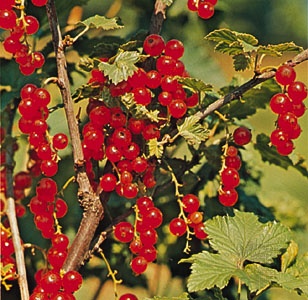currant
shrub
 shrub of the genus Ribes of the gooseberry family (Grossulariaceae), the piquant, juicy berries of which are used chiefly in jams and jellies. There are at least 100 species, natives of temperate climates of the Northern Hemisphere and of western South America. The Rocky Mountains in North America are especially rich in species.
shrub of the genus Ribes of the gooseberry family (Grossulariaceae), the piquant, juicy berries of which are used chiefly in jams and jellies. There are at least 100 species, natives of temperate climates of the Northern Hemisphere and of western South America. The Rocky Mountains in North America are especially rich in species.The currant seems first to have been cultivated sometime before 1600 in the Netherlands, Denmark, and elsewhere around the Baltic Sea. Bushes were taken to settlements in America early in the 17th century; most American varieties, however, originated there. Both red and black currants are used for making tarts, pies, jams, and jellies. Black currants are used in lozenges, for flavouring, and are occasionally fermented. Currants are extremely high in vitamin C and also supply calcium, phosphorus, and iron. Great Britain grows more black currants than any other country.
Currants flourish in cool, moist, northern climates. Clay and silt soils are best. They are propagated by cuttings 200–300 millimetres (8–12 inches) long, usually taken in the autumn and set in the nursery immediately or in spring, 75 to 150 mm apart, with not more than two buds above ground. In the plantation, they are set 1.2–1.5 metres (4–5 feet) apart in rows 1.8–2.4 m distant. Under intensive cropping, currants are planted under grapes, peaches, cherries, and pears because they stand shade very well.
Currants and gooseberries are the chief agencies in the spread of the white-pine blister rust, a destructive disease of the five-leaved pines in Europe and America. The common garden black currant is the favourite host of the blister rust. Because the white pine is a very valuable timber there, the black currant has been declared a menace and is not grown in the northwestern United States; culture of currants and gooseberries has actually been prohibited in some areas.
The name currant is also applied to a seedless raisin (q.v.) frequently used in cooking.
- Aleksandr Andreyevich Bezborodko, Knyaz
- Aleksandr Andreyevich, Knyaz Bezborodko
- Aleksandr Borodin
- Aleksandr Butlerov
- Aleksandr, Count Izvolsky
- Aleksandr Danilovich Menshikov
- Aleksandr Dargomyzhsky
- Aleksandr Dmitriyevich Protopopov
- Aleksandr Dovzhenko
- Aleksandr Fyodorovich Kerensky
- Aleksandr Fyodorovich Mozhaysky
- Aleksandr Glazunov
- Aleksandr Grechaninov
- Aleksandr Isayevich Solzhenitsyn
- Aleksandr Ivanovich Guchkov
- Aleksandr Ivanovich Herzen
- Aleksandr Ivanovich Konovalov
- Aleksandr Ivanovich Kuprin
- Aleksandr Izvolsky, Count
- Aleksandr Kareline
- Aleksandr Khristoforovich Benckendorff, Count
- Aleksandr Khristoforovich, Count Benckendorff
- Aleksandr Mikhailovich Rodchenko
- Aleksandr Mikhaylovich Gorchakov, Prince
- Aleksandr Mikhaylovich, Prince Gorchakov